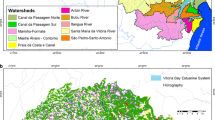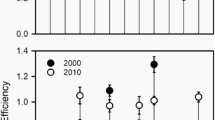Abstract
Agricultural intensification leads to higher diffuse environmental pollution. Successful pollution control requires the continuous monitoring of farming activities, reliable baseline data, and tested computational models for the quantitative assessment of diffuse loads. The study aimed to quantify the diffuse inputs of manure nitrogen (N) and phosphorus (P) to the marine environment from large livestock farms and to identify the lowering effect of the best available techniques of manure/organic fertiliser handling. The study area was the Leningrad and Kaliningrad regions, found in the Russian part of the Baltic Sea catchment area. The total diffuse load in 2017 was estimated by the Russian and Belarus methodologies based on the calculations of the livestock density and the total field application of nitrogen and phosphorus with organic fertilisers. In the Leningrad Region, it was 4571.53 t N year−1 and 280.01 t P year−1; in the Kaliningrad Region—6132.48 t N year−1 and 372.32 t P year−1. The introduction of relevant best available techniques and the supply of all farms with waterproof manure storages and pads could reduce the diffuse load on the catchment in the Leningrad region by 1078.07 t N year−1 and 55.5 t P year−1 and in the Kaliningrad Region—by 1060.43 t N year−1 and 40.5 t P year−1. Such a reduction would provide a marked contribution to fulfilling the nutrient input ceilings set for the Russian Federation under the Helsinki Commission (HELCOM) Baltic Sea Action Plan.







Similar content being viewed by others
Data availability
The authors confirm that the data supporting the findings of this study are available within the article or could be requested from the corresponding author, upon reasonable request. All data are publicly accessible at the sources cited in the text.
Material and/or code availability
Not applicable.
Notes
Management Directive for Agro-Industrial Complex 1.10.15.02–17: “Recommended Practice for Engineering Designing of Systems for Animal and Poultry Manure Removal and Pre-Application Treatment”.
References
Briukhanov, A., Kondratyev, S., Tarbaeva, V., Vorobyeva, E., & Oblomkova, N. (2017). Contribution of agricultural sources to nutrient load generated on the Russian part of the Baltic Sea catchment area. In A. Raupelienė (Ed.). Proceedings of the 8th International Conference “Rural development 2017: Bioeconomy challenges” (pp. 226–231). Aleksandras Stulginskis University, Akademija, Kauno distr, Lithuania. https://doi.org/10.15544/RD.2017.058
Briukhanov, A., Vasilev, E., Kozlova, N., & Shalavina, E. (2021). Assessment of nitrogen flows at farm and regional level when developing the manure management system for large-scale livestock enterprises in North-West Russia. Sustainability, 13, 6614. https://doi.org/10.3390/su13126614
Briukhanov, A. Y., Kondratyev, S. A., Oblomkova, N. S., Ogluzdin, A. S., & Subbotin, I. A. (2016a). Calculation method of agricultural nutrient load on water bodies. Technologies, Machines and Equipment for Mechanised Crop and Livestock Production, 89, 175–183.
Briukhanov, A. Y., Trifanov, A. V., Spesivtsev, A. V., & Subbotin I. A. (2016b). Logical-linguistic modeling in addressing agro-environmental challenges. Proceedings of XIX IEEE International Conference on Soft Computing and Measurements (SCM), (pp. 164–166). Saint Petersburg, Russia, LETI University. https://doi.org/10.1109/SCM.2016.7519716
Briukhanov, A. Y., Vasilev, E. V., Kozlova, N. P., Shalavina, E. V., Subbotin, I. A., & Lukin, S. M. (2019). Environmental assessment of livestock farms in the context of BAT system introduction in Russia. Journal of Environmental Management, 246, 283–288. https://doi.org/10.1016/j.jenvman.2019.05.105
Chen, X., & Bechmann, M. (2019). Nitrogen losses from two contrasting agricultural catchments in Norway. Royal Society Open Science, 6(12), 190490. https://doi.org/10.1098/rsos.190490
Chubarenko, B. V., Kondratyev, S. A., & Bruikhanov, A. Y. (2017). Nutrient load from the Russian portions of the Vistula and Curonian lagoons catchments. Proceedings of the Russian Geographical Society, 149(4), 69–84.
Danilov-Danilyan, V. I., Venitsianov, E. V., & Belyaev, S. D. (2020). Some problems of reducing the pollution of water bodies from diffuse sources. Water Resources, 47, 682–690. https://doi.org/10.1134/S0097807820050048
Database of municipal districts parameters. (2017). https://rosstat.gov.ru/storage/mediabank/Munst.htm. Accessed 16 Jun 2022.
Gonzales-Inca, C. A., Kalliola, R., Kirkkala, T., et al. (2015). Multiscale landscape pattern affecting on stream water quality in agricultural watershed, SW Finland. Water Resources Management, 29, 1669–1682. https://doi.org/10.1007/s11269-014-0903-9
HELCOM. (1992). Recommendation 28E/4. Annex III Criteria and measures concerning the prevention of pollution from land-based sources to convention on the protection of the marine environment of the Baltic Sea area. https://helcom.fi/about-us/convention/annexes-to-the-convention-2/annex-iii/. Accessed 7 Sep 2021.
HELCOM. (2003). The Baltic Sea Joint Comprehensive Environmental Action Programme (JCP) - Ten years of implementation. Baltic Sea Environment Proceedings No. 88. http://archive.iwlearn.net/helcom.fi/stc/files/Publications/Proceedings/bsep88.pdf. Accessed 6 Sep 2021.
HELCOM. (2007). HELCOM Baltic Sea Action Plan. https://helcom.fi/baltic-sea-action-plan/. Accessed 7 Sep 2021.
HELCOM. (2017). Calculation of the fulfillment of the nutrient input ceilings by 2017. https://helcom.fi/wp-content/uploads/2020/08/Calculation-of-the-fulfillment-of-the-nutrient-input-ceilings-by-2017.pdf. Accessed 14 Sep 2021.
HELCOM. (2018a). Input of nutrients by the seven biggest rivers in the Baltic Sea region. Baltic Sea Environment Proceedings No.161. https://helcom.fi/wp-content/uploads/2019/12/BSEP163.pdf. Accessed 9 Sep 2021.
HELCOM. (2018b). Sources and pathways of nutrients to the Baltic Sea. Baltic Sea Environment Proceedings 153. https://www.helcom.fi/wp-content/uploads/2019/08/BSEP153.pdf. Accessed 9 Sep 2021.
HELCOM. (2019). Guidelines for the annual and periodical compilation and reporting of waterborne pollution inputs to the Baltic Sea (PLC-Water). https://helcom.fi/media/publications/PLC-Water-Guidelines-2019.pdf. Accessed 16 Jun 2022.
Intensive rearing of pigs: Information and technical BAT reference book. (2017a). http://www.burondt.ru/NDT/NDTDocsDetail.php?UrlId=1138&etkstructure_id=1872. Accessed 16 Jun 2022.
Intensive rearing of farm poultry: Information and technical BAT reference book. (2017b). http://burondt.ru/NDT/NDTDocsDetail.php?UrlId=1140&etkstructure_id=1872. Accessed 16 Jun 2022.
Jakobsson, C. (ed). (2012). Sustainable Agriculture. 1st ed. Uppsala: Baltic University Press, 505. http://urn.kb.se/resolve?urn=urn:nbn:se:uu:diva-173215. Accessed 29 Jun 2021.
Jansson, T., Andersen, H. E., Hasler, B., et al. (2019a). Can investments in manure technology reduce nutrient leakage to the Baltic Sea? Ambio, 48, 1264–1277. https://doi.org/10.1007/s13280-019-01251-5
Jansson, T., Andersen, H. E., Gustafsson, B. G., et al. (2019b). Baltic Sea eutrophication status is not improved by the first pillar of the European Union Common Agricultural Policy. Regional Environmental Change, 19, 2465–2476. https://doi.org/10.1007/s10113-019-01559-8
Kaur, K., Vassiljev, A., Annus, I., & Stålnacke, P. (2017). Source apportionment of nitrogen in Estonian rivers. Journal of Water Supply: Research and Technology-Aqua, 66(7), 469–480. https://doi.org/10.2166/aqua.2017.036
Loague, K., & Corwin, D. L. (2006). Point and nonpoint source pollution. In: Encyclopedia of Hydrological Sciences. Part 8. Water Quality and Biogeochemistry. John Wiley & Sons, Ltd. https://doi.org/10.1002/0470848944.hsa097
Luo, X., & Yang, J. (2019). A survey on pollution monitoring using sensor networks in environment protection. Journal of Sensors, 2019, 6271206. https://doi.org/10.1155/2019/6271206
Methodology for calculating nutrient loss and assessment of the future pollution state of small rivers 0212.19–99. (1999). http://pravo.levonevsky.org/bazaby11/republic47/text097/index.htm. Accessed 6 Sep 2021.
Nainggolan, D., Termansen, M., Gyldenkarne, S., Andersen, H. E., & Hasler, B. (2018). Water quality management and climate change mitigation: Cost-effectiveness of joint implementation in the Baltic Sea Region. Ecological Economics, 144, 12–26. https://doi.org/10.1016/j.ecolecon.2017.07.026
Panagopoulos, Y., Makropoulos, C., & Mimikou, M. (2011). Diffuse surface water pollution: Driving factors for different geoclimatic regions. Water Resources Management, 25, 3635. https://doi.org/10.1007/s11269-011-9874-2
Popov, V. D., Spesivtsev, A. V., Sukhoparov, A. I., & Spesivtsev, V. A. (2016). Use of logical-linguistic models to predict the retained biological potential of grasses during their conservation. Proceedings of XIX IEEE International Conference on Soft Computing and Measurements (SCM), (pp. 244–246). Saint Petersburg, Russia, LETI University. https://doi.org/10.1109/SCM.2016.7519741
Pozdnyakov, Sh. R., & Kondratyev, S. A. (2017). Formation of nutrient load on the Baltic Sea from the Russian territory and the possibility of its reduction in accordance with the requirements of the HELCOM Baltic Sea Action Plan. Regional Ecology, 1(47), 65–73.
Sandström, S., Futter, M., Kyllmar, K., Bishop, K., & O’Connel, l D. & Djodjic, F. (2019). Particulate phosphorus and suspended solids losses from small agricultural catchments: Links to stream and catchment characteristics. Science of the Total Environment, 71, 134616. https://doi.org/10.1016/j.scitotenv.2019.134616
Subbotin, I. A., & Vasilev, E. V. (2021). Forecasting model the complex negative impact of agricultural production technologies on water bodies. Engineering Technologies and Systems, 31(2), 227–240. https://doi.org/10.15507/2658-4123.031.202102.227-240
Svendsen, L. M. (ed). (2019). Applied methodology for the PLC-6 assessment. https://helcom.fi/wp-content/uploads/2020/01/PLC-6-methodology.pdf. Accessed 6 Sep 2021.
Szalińska, E., Orlińska-Woźniak, P., & Wilk, P. (2018). Nitrate vulnerable zones revision in Poland – Assessment of environmental impact and land use conflicts. Sustainability, 10(9), 3297. https://doi.org/10.3390/su10093297
Vasileva, N. S., Vorobyeva, E. A., Minin, V. B., & Vasilev, E. V. (2019). Survey of manure storages in Leningrad Region. Technologies, machines and equipment for mechanised crop and livestock production, 3(100), 179–187. https://doi.org/10.24411/0131-5226-2019-10201
Funding
The funding was provided by the Institute for Engineering and Environmental Problems in Agricultural Production (IEEP)—a branch of the Federal State Budgetary Scientific Institution “Federal Scientific Agroengineering Center VIM”, Saint Petersburg, the Russian Federation.
Author information
Authors and Affiliations
Contributions
Conceptualization: Andrey Izmaylov and Vladimir Popov; methodology: Aleksandr Briukhanov and Sergey Kondratyev; formal analysis and investigation: Aleksandr Briukhanov, Natalia Oblomkova, and Oleg Grevtsov; writing—original draft preparation: Aleksandr Briukhanov and Natalia Oblomkova; writing—review and editing: Aleksandr Briukhanov and Natalia Oblomkova; supervision: Andrey Izmaylov and Vladimir Popov.
Corresponding author
Ethics declarations
Ethics approval
Not applicable.
Consent to participate
Not applicable.
Consent for publication
Not applicable.
Competing interests
The authors declare no competing interests.
Additional information
Publisher's Note
Springer Nature remains neutral with regard to jurisdictional claims in published maps and institutional affiliations.
Highlights
• Intensive agriculture is a major source of nutrient diffuse inputs to water bodies.
• Large livestock farms in the Leningrad Region and livestock farming in the Kaliningrad Region were listed by HELCOM as Hot Spots.
• Only 40% of manure produced in the Leningrad and Kaliningrad Regions are used in organic fertilisation .
• The diffuse nitrogen and phosphorus inputs from both applied and unaccounted for manure were calculated by the Russian and Belarus methodology.
• The BAT introduction and the monitoring and control over the organic fertilisation can contribute to around 15% reduction of nitrogen input and above 8% reduction of phosphorus input.
Supplementary Information
Below is the link to the electronic supplementary material.
Rights and permissions
About this article
Cite this article
Izmaylov, A., Popov, V., Briukhanov, A. et al. Quantification of nitrogen and phosphorus inputs from farming activities into the water bodies in the Leningrad and Kaliningrad regions. Environ Monit Assess 194, 508 (2022). https://doi.org/10.1007/s10661-022-10155-z
Received:
Accepted:
Published:
DOI: https://doi.org/10.1007/s10661-022-10155-z




